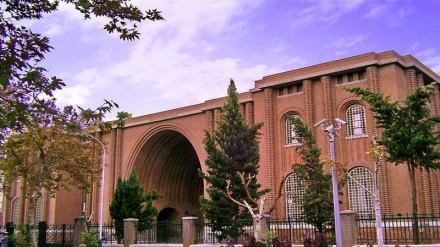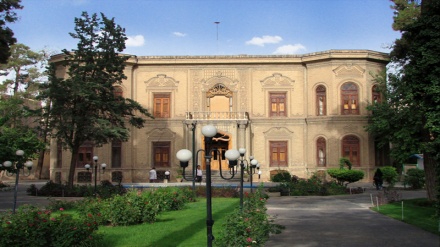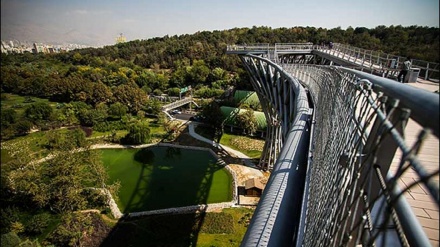Iran your attractive destination (218)
Today, we become familiar with Vahdat Hall and the Theatrical Complex, Ta’atr-e Shahr.
Roudaki Hall Complex consisted of two performance halls; one of which was referred to as Roudaki Hall, located next to another small hall. After the victory of Iran’s Islamic Revolution, and concurrent with the birth anniversary of the Prophet of Islam, Mohammad (Blessings of God upon him and his progeny), the larger hall was renamed as Vahdat Hall, while the smaller hall was named after the renowned Iranian poet of the 3rd Century AH, Roudaki.
Vahdat Hall is one of the largest concert halls, which operates under the guidance of the Ministry of Culture and Islamic Guidance.
This complex was constructed in the year 1967 AD by an Iranian architect of Armenian descent, based on the model of Vienna Opera Hall. The construction of this complex took ten years. Its foundation stands at roughly 15700 square meters, and includes a hall on the ground floor and three balconies, which can accommodate a total of 900 people. It is a three-story building, with two eastern and western gateways. This hall has a main stage and four mobile stages. The related spaces are allocated behind the stage, including the makeup and audition rooms. The stage is made of four separate parts. The front part of the stage is allocated for performance of ballets and operas and its height can be lowered up to three meters. The two side parts of the stage can be elevated by up to six meters and the stage’s back part can rotate.
The administrative section is a seven-story building which has been constructed back stage. It renders administrative services, and maintains audition halls and a restaurant.
Countless prominent Iranian and foreign artists have attended and performed in Vahdat Hall.
The construction of Roudaki Hall started concurrent with construction of Vahdat Hall. It has a main hall in the third floor; and a balcony on the 4th floor, with an overall capacity of 200 people.
Roudaki Hall’s stage is fixed and has been prepared for performance of orchestras and music bands. Moreover, the back end of the stage has been considered for performance of Choirs.
This hall is equipped with cameras, an acoustic system, portable curtains, and a video projector. Also, sound reflectors have been designed in the ceiling, making the performers needless of microphones.
Roudaki Hall has hosted traditional and classic music bands.
The most active theatrical complex of Iran, Ta’atr-e Shahr, was constructed more than forty years ago on the western corner of Daneshjou Park, next to one of the most well-known crossroads of Tehran, Vali Asr Crossroads.
In the year 1967, the preliminary measures were taken for construction of this theatrical complex by a consulting engineers company. Meanwhile, this complex was prepared in the year 1972 AD, with a modern theatrical hall.
This building is covered with brickworks and accommodates a number of beautiful and memorable pillars. It is covered with traditional Iranian decorations. Its courtyard is covered with pebble stone, which grants it an especial beauty.
This theatrical complex has turned into a public venue, which grants peace of mind and comfort to its visitors.
This theatrical complex which initially was constructed with one main hall currently operates with five halls for performance. Meanwhile, the main hall can accommodate 579 people.
In the second part of today’s episode, we become familiar with Saba Museum.
Abul-Hassan Saba is one of the celebrated and famed Iranian musicians in the field of classical Iranian music. He was born in Tehran in the year 1902. His father, Abul-Qasem Kamal Ul-Saltaneh, was one of the virtuous figures and art-lovers of his era. He was also a physician and a man of letter. He played Setar musical instrument and was the first teacher of his son. Saba in addition to playing musical instruments, composed songs every now and then, and in addition to music, was well-versed in Iran’s classical literature, and English language. He was also well-informed in the domain of modern Iranian literature. This great musician admired the poems of contemporary Iranian poet, Nima Youshij.
His main musical instrument was violin. However, he was also skilled in playing a number of other musical instruments.
At a young age, he attended the painting classes of renowned Iranian painter, Kamal Ul-Molk. A number of paintings of this great Iranian musician, which show scenic landscapes, flowers, birds, and animals, are on display in Saba Museum.
In the year 1927, Saba was delegated with the responsibility to establish a music school in the city of Rasht in northern Iran. He took up residence in this city for two years, teaching music. He also traveled to northern Iran villages and foothills, collecting local music.
Upon the establishment of Tehran Radio Station in the year 1939, Saba performed music in this radio station, while concurrently teaching music and researching in this domain. In the waning years of his life, he held music lessons at his home.
He groomed some of the most famous musicians of Iran.
Saba passed away at the age of 55 in the year 1957, due to heart failure. Based on his will, his home turned into a museum in the year 1974 AD.
MR/ME


